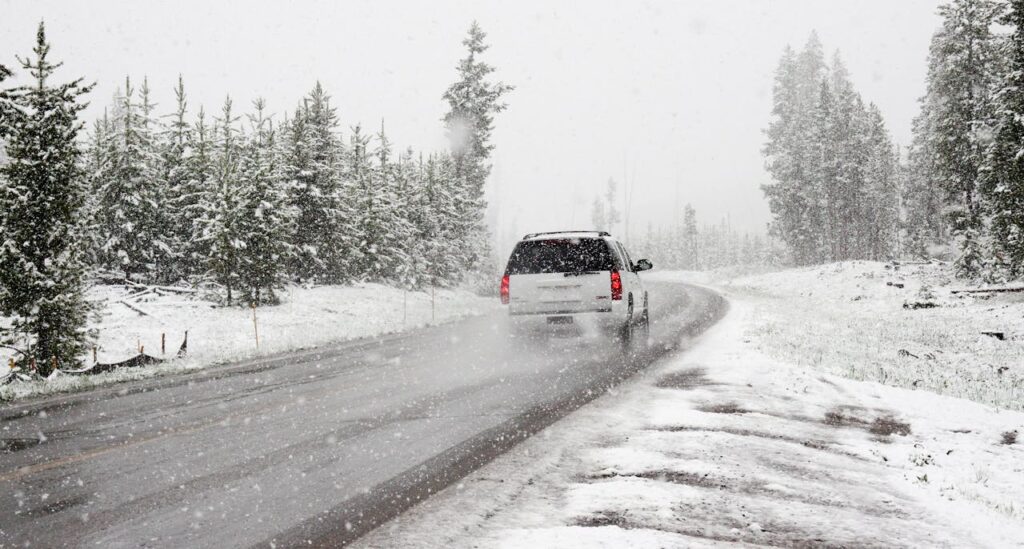Driving in snowy conditions can be tricky, and it’s important to be prepared. Winter weather creates challenges for drivers, from icy roads to low visibility. Taking steps to drive safely in these conditions helps keep you, your passengers, and your car safe from accidents.
Getting your car ready for winter is the first step. This means checking your vehicle’s maintenance, ensuring proper tires are on, and having a plan if you face emergency situations. These precautions make a big difference when roads are slippery and covered in snow.
Being a careful driver also helps avoid accidents during winter. This includes driving at the right speed, keeping greater distances from other vehicles, and knowing how to handle icy spots on roads. With the right approach, you can reduce the risk of accidents and insurance claims during the cold months.
Preparing Your Vehicle for Winter Roads
Getting your vehicle ready for the winter months is crucial for staying safe on the road. Proper preparation can help you avoid accidents and reduce the risk of car insurance claims.
Essential Vehicle Maintenance Tips:
1. Check Your Battery: Cold weather can weaken your car’s battery. Make sure it’s fully charged and in good condition. If it’s old, consider replacing it.
2. Inspect Your Antifreeze Levels: Antifreeze is important for your car’s engine to function in cold temperatures. Ensure it’s filled to the right level.
3. Examine Your Brakes: Brakes need to be in top shape for winter driving. Listen for strange noises and get them serviced if needed.
4. Verify Wiper Blades and Washer Fluid: Visibility is key in snow. Use winter-grade wiper fluid and make sure your wiper blades are effective.
5. Conduct an Oil Check: Cold weather can affect oil performance, so use oil that suits your winter climate.
Importance of Winter Tires and Chains:
– Winter Tires: These tires are specifically designed for cold weather. They offer better grip on snowy and icy roads. It’s advisable to switch to winter tires before heavy snowfall starts.
– Tire Chains: In extremely snowy or icy conditions, tire chains provide extra traction. Ensure they are legal in your area and practice installing them before you really need them.
Taking these steps can make driving in winter safer for you and others on the road.
Safe Driving Practices in Snowy Conditions
Driving in snowy conditions requires careful attention and adjustments. Proper techniques can keep you safer and help prevent accidents.
Adjusting Speed and Safe Following Distances:
– Lower Your Speed: Snow and ice reduce tire traction, which means you’ll need to drive more slowly to maintain control. Adjust your speed based on the road conditions.
– Increase Following Distance: Keep a longer distance between your vehicle and the one ahead to give yourself more time to stop. Aim for at least eight to ten seconds following distance.
Techniques for Navigating Icy Roads:
1. Brake Gently: Slamming on brakes can lock the wheels and cause skidding. Use gentle, steady pressure.
2. Use Lower Gears on Hills: Lower gears help maintain control over your vehicle on snowy hills.
3. Steer into a Skid: If your car starts to skid, remain calm and steer in the direction you want your front wheels to go. Avoid oversteering.
4. Avoid Cruise Control: Using cruise control on slippery roads can be dangerous. Maintain manual control of your speed.
By incorporating these safe driving practices, you can navigate winter roads more effectively and reduce the risk of accidents.
Understanding Road Conditions and Weather Forecasts
Staying informed about road conditions and the weather is crucial for safe winter driving. It helps you plan your routes and prepare for unexpected changes.
How to Access Accurate Weather Information:
1. Use Weather Apps: Many apps provide real-time updates on weather conditions. Check these before heading out.
2. Listen to Local Radio Stations: Radio stations often report on road closures and weather updates during winter storms.
3. Follow Transportation Departments: Websites and social media accounts of local transportation departments offer valuable updates on road conditions.
Recognizing Hazardous Road Situations:
– Black Ice: This thin coat of ice is almost invisible and forms on shaded roads or bridges. Take caution and drive slowly in such areas.
– Snow Drifts: High winds can create piles of snow on roads that are hard to see. Look out for areas where snow has gathered unexpectedly.
– Fog and Low Visibility: Foggy conditions make it hard to see ahead. Use fog lights if your vehicle has them, and be alert for vehicles stopped on the road.
Knowing how to assess road conditions and use weather information effectively is key to staying safe and avoiding problems during winter travel.
Emergency Preparedness and Safety Precautions
Preparing for emergencies can make a big difference if you encounter trouble while driving in winter conditions. Having the right supplies and knowledge is crucial for keeping you safe.
Must-Have Items for a Winter Car Emergency Kit:
– Warm Blankets: Keep blankets in your car to stay warm if you break down.
– First-Aid Kit: This is essential for handling minor injuries until help arrives.
– Flashlight and Batteries: Useful for signalling for help or checking your car in the dark.
– Non-Perishable Snacks and Water: These can keep you nourished if you are stranded for a while.
– Shovel and Ice Scraper: Handy tools for freeing your vehicle from snow and scraping ice from windows.
Steps to Take if Stranded in Snow:
1. Stay with Your Vehicle: It’s safer to remain with your vehicle as it offers shelter and makes it easier for rescuers to find you.
2. Keep Exhaust Pipe Clear of Snow: Check that the exhaust pipe is free of snow to prevent carbon monoxide poisoning.
3. Use Your Emergency Signals: Turn on hazard lights and raise the hood to make your car visible.
Being prepared ensures you are ready to handle winter driving challenges safely and effectively.
Conclusion
The snowy months bring unique challenges, but you can confidently navigate winter roads with the right preparation and strategies. From ensuring your vehicle is ready to understanding road conditions and being prepared for emergencies, each step plays a crucial role in keeping you safe. Following these tips helps prevent accidents and minimizes the risk of needing to file car insurance claims.
Now is the perfect time to review your winter driving strategies and car insurance coverage. At Ai Insurance Organization Inc., we understand the importance of proper protection. Contact us today to learn more about our car insurance options and ensure you are fully covered for the winter months. Stay safe, and drive carefully!
Disclaimer: The information provided in this article is intended for illustrative purposes only and should not be considered as actual insurance advice. Our articles offer insights and general guidance on various insurance topics; however, they do not substitute professional advice tailored to your specific circumstances. For expert, personalized insurance advice and solutions, please contact our licensed insurance brokers.












